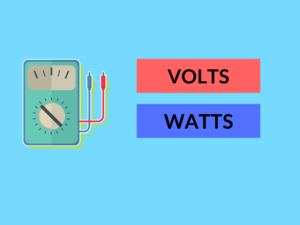The Difference Between Watts and Volts
Introduction
Have you ever wondered about the difference between watts and volts? These two terms are commonly used in the field of electrical engineering, but many people often confuse them or use them interchangeably. In this article, we will explore the definitions, examples, and uses of watts and volts, and highlight their key differences. By the end, you’ll have a clear understanding of these important concepts in electricity.
What is Watts?
Watts is a unit of power, which measures the rate at which work is done or energy is transferred. It is named after James Watt, the Scottish engineer who made significant contributions to the development of the steam engine. In simple terms, watts represent how much energy is used or produced in a certain amount of time.
Examples of Watts
Here are a few examples to help you understand the concept of watts:
- A 100-watt light bulb consumes electricity at a rate of 100 watts per hour.
- An electric motor rated at 500 watts can deliver 500 joules of energy per second.
- A hairdryer with a power rating of 1,200 watts uses 1.2 kilowatts of electricity per hour.
Uses of Watts
Watts are used to measure power consumption or generation in various electrical devices and systems. They help us determine energy efficiency, estimate electricity bills, and select appropriate electrical equipment for specific applications.
What is Volts?
Volts, on the other hand, is a unit of electrical potential difference or voltage. It is named after Alessandro Volta, an Italian physicist who invented the electric battery. Volts represent the force or electric potential that drives the flow of electric charge.
Examples of Volts
Here are a few examples to help you understand the concept of volts:
- Household electrical outlets in the United States provide a standard voltage of 120 volts.
- A car battery typically supplies around 12 volts of electricity.
- High-voltage power lines can transmit electricity at tens or hundreds of thousands of volts.
Uses of Volts
Volts are essential for determining the suitability of electrical devices and systems for specific voltage requirements. They help ensure the proper functioning and safety of appliances, machinery, and electronic equipment.
Differences Between Watts and Volts
| Difference Area | Watts | Volts |
|---|---|---|
| Definition | Units of power | Units of electrical potential difference |
| Symbol | W | V |
| Named After | James Watt | Alessandro Volta |
| Measurement | Rate of energy transfer | Force driving the flow of electric charge |
| Commonly Used In | Power consumption, generation, and efficiency | Voltage specifications and electrical safety |
| Examples | Light bulbs, motors, electrical appliances | Electrical outlets, batteries, power lines |
| Formula | Watts = Volts x Amperes | No direct formula |
| Unit Conversions | Watts can be converted to kilowatts | Volts can be converted to millivolts or kilovolts |
| Effect on Electricity Bill | Higher watts result in higher energy consumption | Higher volts can lead to increased electricity costs |
| Impact on Electrical Devices | Higher watts may require thicker cables or higher-rated fuses | Higher volts may require voltage transformers or voltage regulators |
Conclusion
In summary, watts and volts are distinct units of measurement in the field of electricity. Watts measure power, representing the rate at which energy is used or produced, while volts measure electrical potential difference or voltage. Understanding the difference between these two concepts is crucial for evaluating power consumption, selecting appropriate electrical equipment, and ensuring the safety and efficiency of electrical systems.
Knowledge Check
- Which unit measures the rate at which work is done or energy is transferred?
a) Watts
b) Volts
c) Amperes
d) Joules
Answer: a) Watts - Who is James Watt?
a) An Italian physicist
b) A Scottish engineer
c) An American inventor
d) A French mathematician
Answer: b) A Scottish engineer - What do volts represent?
a) Force driving the flow of electric charge
b) Rate of energy transfer
c) Unit of power
d) Amount of electrical resistance
Answer: a) Force driving the flow of electric charge - What formula is used to calculate watts?
a) Watts = Volts x Amperes
b) Amperes = Volts / Ohms
c) Volts = Amperes x Ohms
d) Ohms = Volts / Amperes
Answer: a) Watts = Volts x Amperes - How can volts be converted to other units?
a) Volts to millivolts or kilovolts
b) Volts to amperes or ohms
c) Volts to watts or joules
d) Volts to newtons or seconds
Answer: a) Volts to millivolts or kilovolts - What can higher watts result in?
a) Increased electrical potential difference
b) Lower energy consumption
c) Thicker cables or higher-rated fuses
d) Decreased electricity costs
Answer: c) Thicker cables or higher-rated fuses - Why might higher volts require voltage transformers or regulators?
a) To reduce energy consumption
b) To increase electrical resistance
c) To control the flow of electric charge
d) To ensure electrical safety and proper functioning
Answer: d) To ensure electrical safety and proper functioning - Which unit is named after Alessandro Volta?
a) Amperes
b) Watts
c) Joules
d) Volts
Answer: d) Volts - What is the unit conversion of watts?
a) Watts to kilowatts
b) Watts to kilovolts
c) Watts to milliwatts
d) Watts to megawatts
Answer: a) Watts to kilowatts - What are volts used for?
a) Measuring power consumption
b) Selecting electrical equipment
c) Estimating electricity bills
d) Measuring energy efficiency
Answer: b) Selecting electrical equipment
Related Topics
- The Basics of Electrical Power
- Understanding Voltage and Current
- Choosing the Right Wattage for Your Appliances
- The Role of Volts in Electrical Safety
- Power Factor: Optimizing Energy Efficiency


